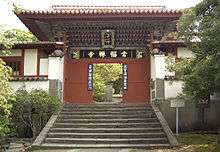Ōbaku Zen architecture

The Ōbaku school of Zen arrived in Japan in the middle of the seventeenth century, several centuries after the other Zen schools, and as a consequence its temples typically have a different architecture, based on Chinese Ming and Qing architectures.[1]
A great example of the style is Manpuku-ji in Uji, near Kyoto, whose main building, the Daiyūhōden, was built in 1668.
Another important Ōbaku temple is Sōfuku-ji, built in 1629 in Nagasaki by Chinese immigrants.[1] The Daiippōmon, a National Treasure, was built in 1644 by Chinese carpenters.[2] Rebuilt in 1694 with material imported from China, it is one of the best examples of the style.[1] Painted in typically Chinese polychromy, it has four-step brackets ("tokyō") in the front and back, and ordinary three-step brackets on the sides.[1]
Notes
- 1 2 3 4 Nishi, Hozumi (1996:35)
- ↑ Parent, Mary Neighbour. Japanese Architecture and Art Net Users System. Daiippoumon, retrieved on 4-14-11
References
- Nishi, Kazuo; Hozumi, Kazuo (1996) [1983]. What is Japanese architecture? (illustrated ed.). Kodansha International. ISBN 4-7700-1992-0. Retrieved 2009-11-11.
| Wikimedia Commons has media related to Obaku Zen architecture. |